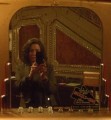ASK App + Group Tours: Making Hard Choices
Earlier this week, Sara introduced the topic of ASK’s new collaboration with our Group Tours office and our efforts to shape the content of our first highlights tour. We’re excited to be offering an alternative to guided tours, and we already know that our “regular” ASK users appreciate receiving recommendations for what to see. When the ASK team was visible on the floor, they regularly fielded visitor questions like, “What are the most important things here?” or “We only have an hour or so—what shouldn’t we miss?”
So, which works of art would we choose to offer in a self-guided tour scenario? The Museum currently has galleries on four floors, not to mention twelve collection areas ranging from ancient Egypt to contemporary art. If you’ve ever walked through the entire building or flipped through one of our highlights publications, you can guess what a challenge this would be. How can we convey an idea of our “greatest hits” through a manageable number of objects, keeping in mind that a visiting group typically spends from an hour to an hour and a half in the galleries?
In a series of brainstorming meetings, and through multiple testing sessions and follow-up conversations with colleagues and friends, we came up with a list of criteria for each selection that helped us to sort through our wish-list:
- Historical significance: it had to have clear importance within art history and the collection
- A good story: it had to offer an intriguing narrative, through its creator, its imagery, its provenance, etc.
- Accessibility: it had to be installed in a way that visitors could find it and easily view it as a group—nothing placed in a tight corner or high on a wall, for example. It also had to be located on a pathway that made sense, moving people through the building wit limited backtracking and easy access to stairs and elevators.
- Visual excitement: it had to offer opportunities for close looking
- Connections: it needed to be something we could connect to other works in the tour, through a theme, a technique, etc.
Of course, certain challenges arose during our planning and testing. We had to keep up with gallery rotations, for example: El Anatsui’s Black Block fit all our criteria, but then we learned that it was scheduled to be deinstalled, so we chose another contemporary work. There were also situations where we initially included a work that seemed like an obvious choice, only to struggle with it during testing. Initially we wanted to include a Pre-Dynastic Egyptian sculpture of a female figure because it has the distinction of being the oldest work on display in the Museum. During test chats, however, we realized it was hard for visitors to locate this small object in the galleries; also, our discussion was somewhat limited, since scholars haven’t been able to determine many specific facts about it.
We were also hearing that some visitors would have liked a wider choice of objects, and that they were interested in some works, but not in others. This feedback led us back to two of our ongoing concerns: the balance of structure and flexibility in our script and the balance of freedom and guidance in the visitor’s experience. During one of our brainstorming sessions, the ASK team came up with a new idea: rather than a fixed list of six or eight stops, why not offer two parallel lists, “highlights” and “hidden gems”? Then visitors could mix and match, depending on their interests. It could be like a menu of entrees and side dishes, or a subway line with local and express stops. We’d been feeling stymied, but this idea perked us up: we could include more key objects, while offering visitors a more customized experience.
As we continued to test our evolving tour itinerary with groups of colleagues and outside participants, however, we soon realized that we needed to give just as much consideration to engagement as content. I’ll be discussing some of those related challenges in a future post.

Jessica Murphy, Manager of Visitor Engagement, joined the Brooklyn Museum in 2015 as a member of the ASK team. In her current position she leads the team in their interactions with the Museum’s visitors through the ASK app and coordinates their ongoing training and development. Jessica received her B.A. from Fordham University and her M.A. and Ph.D. in Art History (with a concentration in American Art) from the University of Delaware. She previously worked as Research Associate at the Metropolitan Museum of Art (contributing to exhibitions and publication such as “Alfred Stieglitz and His Artists: Matisse to O’Keeffe” and “The American West in Bronze”), as Contractual Educator at the Met, and as Curatorial Assistant at the Philadelphia Museum of Art. She has also worked as a freelance writer on cultural topics. She welcomes any opportunity, in any medium, to connect people and art.



Start the conversation